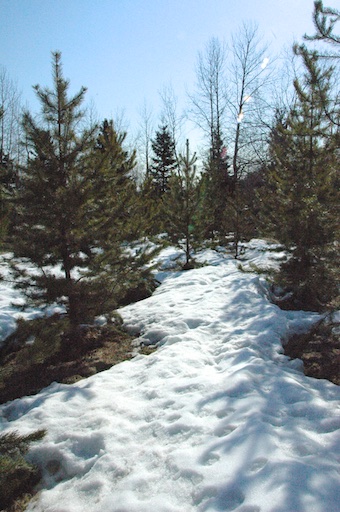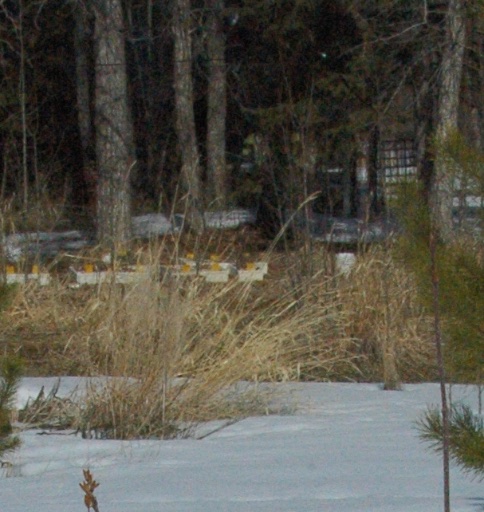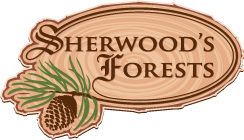
The effect of a single row of trees only 10 feet tall. That band is a bit warmer in winter, with less wind and desication, and a bit damper in spring.

This picture and the next one pictures are taken on the same day, about 100 feet apart. Here the lodgepole pines catch the drifting snow, and between the trees is still over a foot deep.

But in this one there is a 30 foot band on this side of the tall spruce where the warm air is trapped on the south side of the trees and snow comes early.
Micro Climate
How to Grow What Shouldn't grow here
Some years ago we noticed this lavender wild flower growing in corner of the L of our house. Laura posted pics and a friend identified as early Meadow Rue. I looked up the range map of this plant, and it's mostly an eastern plant, with only a few reported sightings out west. Two years later we had another on the east side of the greenhouse.
With some attention, you can use microclimates to your benefit. Some subtle difference that may enable a plant to do much better than it would otherwise.
Here are some examples of microclimate planning:
Cold air drainage On a clear night the top of the soil radiates heat into space. Several inches of air next to the dirt cool off, then slide off down the hill, collecting in the valleys. Some plants, notably the stone fruits (plums, apricots, cherries...) tend to bloom early. (Vancouver has a cherry blossom festival in February!) By putting them on a hill 5-10 vertical feet above the bottom can make the difference between loosing your crop from a late frost.
On an early morning, just at sunrise, when it's calm and clear, walk around your yard. You may be able to feel the difference. Notice where the fog pockets are. Notice where the dew is heavier.
Early Spring We have a row of spruce trees near the house. Those trees hold with spring warmth, and the snow is gone 3 weeks before the rest of the yard. Next year I'm putting in a hundred crocuses. See if I can have the first crocus in the neighborhood.
Watch the where the snow melts first. This will be the first workable soil in spring, and will be warm sooner than the rest of the garden.
Postponing Spring Back to those stone fruit. Apricots are borderline here. Many years they bloom, but a late frost takes them out. You need to trick them into holding back. Try this: On the 15th of May, near noon, go to the north side of a building in your yard, and mark the shadow line. You can also use the north side of a shelterbelt. Plant your apricot 6 feet in from the edge of the line. This spot is almost certainly a place where snow collects in winter, and is late moving off in summer. This will keep the roots cold enough to postpone bud break by a week. The top of the tree will be in the sun in late August so the fruit has a chance to get ripe.
Collecting Snow I have 8 acres that I use for growing trees. I have 30 foot high poplar trees every 200 feet. The rest of my fields are bare right now (Early March, dry winter) but the shelterbelt protected area still has 8 inches of snow. In winter this extra snow means that the hoof rats (deer) have to work harder to get through deeper snow. Mostly they don't. They go somewhere else where they don't have to work as hard.

Conifers are even better than poplar for slowing down the wind, and stacking snow.
Got something to say? Email me: sfinfo@sherwoods-forests.com
Interesting? Share this page.
Want to talk right now? Call me: (8 am to 8 pm only, please) 1-780-848-2548
Do not arrive unannounced. Phone for an appointment. Why? See Contact & Hours That same page gives our hours of operation.
Back to Top
Copyright © 2008 - 2021 S. G. Botsford
Sherwood's Forests is located about 75 km southwest of Edmonton, Alberta. Please refer to the map on our Contact page for directions.
